
What is a Lead?
A lead is someone who has expressed interest in your company or product.
A lead can express interest through visiting your site, visiting one of your trade shows or events, and/or filling out a form on the website to get more information about products and services offered by you.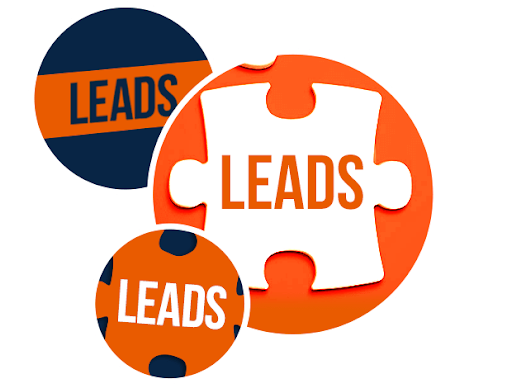
What is it that you need to get started? A lead.
You’re searching for someone to speak with, that could give you something to look into. It could be someone in the Rolodex or someone coming to you with a story that will break wide open.
Are they a good lead that will give you a front-page story, or is it a dead-end? It all depends on how the conversation goes.
It’s not that difficult to directly translate this to the business world.
Either you buy or put together a list of your leads (e.g., Rolodex), or via inbound techniques/advertising, they come to you (e.g., a person coming directly to you).
There’s a reason our company name starts with “Lead”. It’s the start of every deal that you convert.
LeadFuze is a software solution that provides accurate leads automatically while integrating with sales outreach tools to allow you to contact those freshly verified leads.
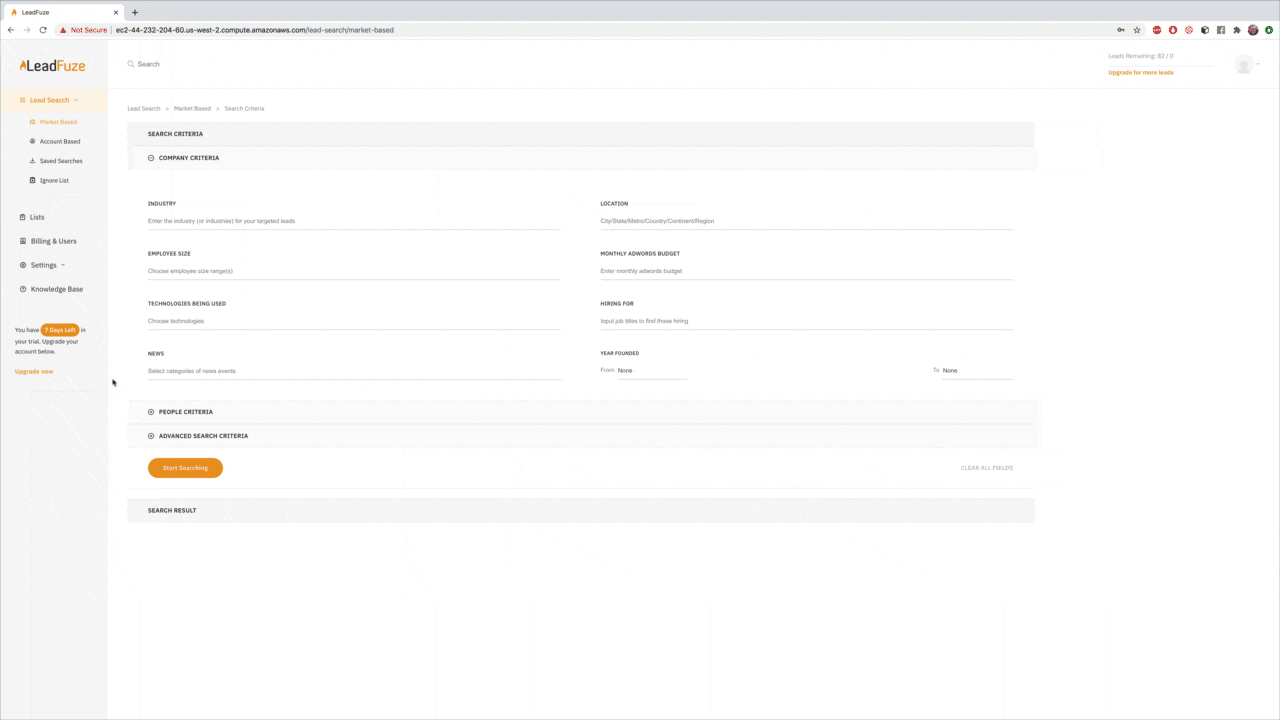
You need to decipher which leads could make it to print (or closed-won) and those that aren’t worth the time. Start by knowing the type of stories buyer personas that really fit into your newspaper organization.
Again, the lead could be nothing, or there could be something that makes you want them to stick around and keep talking.
The point is: a Lead isn’t a sure thing.
One of the dictionary definitions states that a lead is, “a slight or indirect pointing to something”.
Leads may be in the form of:
- Names on a list: Either one you’ve drummed up yourself through research, or bought from a third party.
- Referrals: Either from colleagues or current clients.
- People who’ve responded: If someone responds to your cold emails and phone calls, they’re still a lead until you qualify them a bit.
- Inbound/Advertising: They’ve come to you and want answers. A great place to be in the sales world.
Before you can say that they are no longer a lead, you have to speak with them. There has to be an initial conversation for reps to determine whether or not a lead is an uninterested party or potential prospect.
When a lead comes into your outreach process, they should fit a certain mold. Whether that is certain firmographic/demographic data or someone who is interested in your advertising or content online.
That said, they may have made little to no indication of interest in your products. That’s because leads need to be qualified in order to become prospects.
Higher quality names, in the beginning, should give you a higher percentage of leads who move along in the overall sales process. However, you won’t know until you have a conversation.
Typically, reps will have to chip away at leads in order to have an initial conversation.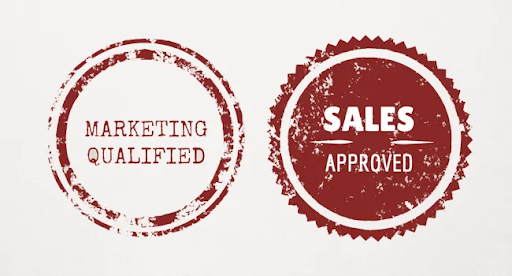
Depending on whether or not you’re B2B, Tech, or even direct to consumer, the questions will be different. All questions should be used to help you determine how likely a lead is to close.
3 Types of leads
A lead is not always ready for sales conversations right away because they need to be qualified first.
There are three types of leads that can qualify into opportunities; IQLs, MQLs, SQLs.
The type will determine how long it takes them to become an opportunity.
1. Information Qualified Leads (IQLs)
Information Qualified Leads are people who have visited your website or downloaded an information product. They are leads that have provided you with their contact information in exchange for gaining access to valuable information.
Examples include leads who subscribe to your newsletter, as well as people who enter their contact information in one of your lead forms so that they could download your educational e-book.
Yet, they are not ready to become prospect leads because they need additional contact and nurturing before being qualified.
These people are starting to research their problems and still aren’t considering your product or service as a solution.
2. Marketing Qualified Leads (MQLs)
Marketing Qualified Leads are leads generated from marketing efforts such as ads, blog posts, or other lead generation activities.
These leads can highly turn into potential customers.
When IQLs request information about your products or services, they become Marketing Qualified Leads. MQLs are curious about your offering, but still aren’t sure they want to do business with you.
They’ll often download a resource that provides more information on how your product or service works or how effective it is (e.g., a case study).
While they might be indecisive, MQLs are a lot more receptive to a sales pitch compared to Information Qualified Leads.
3. Sales Qualified Leads (SQLs)
A Sales Qualified Lead is a lead that has shown interest in purchasing your company’s products and services.
Researched your company, expressed interest in what you offer, and has been determined to be a good fit for your offering by your sales team.
The way these people show interest is often by signing up for a free trial of your service or requesting a demonstration.
SQLs require a Lead nurturing process through your Sales lead management system or strategy, as they have a high probability of turning into customers and should be followed up with directly.
All leads need nurturing, but MQLs usually need less than IQLs or SQLs because they have a higher level of intent that exclusively focuses on purchasing your product or service, presenting sales opportunities.
What is a Prospect?
A Prospect is someone who has a high probability of becoming a lead or converting to an opportunity.
A lead that has been proven to be a fit for your products/services and is progressing toward a decision by having a continuous conversation with a sales rep.
The prospect needs more information before they are ready for sales conversations, so we nurture them by sending nurturing emails regularly.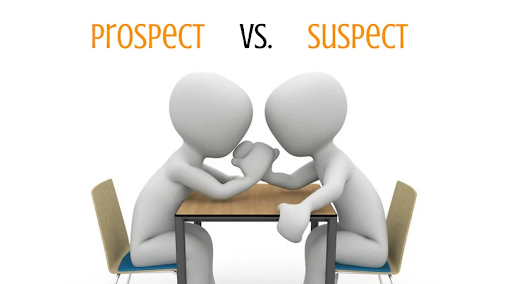
Imagine you’ve called on one of your leads and received a great tip that could just be the story you’ve been looking for.
You’ve asked them the questions, and they’ve answered them all with the details you hoped to hear. At this point, your lead becomes a prospect. Following a prospect is where the actual legwork begins, but it’s also the exciting part.
In the business world, it’s just as exciting.
The lead has been qualified and hopefully is willing to have continuous correspondence with you.
This lead has the problems that your products solve, a budget that warrants your pricing, and a timeline that puts them near ready for a decision. However, you may not get the sale right away.
In B2B scenarios (significantly larger organizations), multiple people are involved in the buying decision.
Your one-lead story becomes a multi-person operation.
Induct more interviews, find the right person to talk to, and schmooze everyone to get the intel you want.
Call it journalism, call it sales — not much of a difference.
You can have prospects that need a bit more information and time. Share on XThat’s ok.
The prospect stage isn’t necessarily a short one.
This phase could actually be the longest, given the direct time that you’ll be involved. Leads are leads until you get to have a conversation.
Just make sure that you factor that into your overall process to deem it worthwhile.
Although, you shouldn’t continue to call them “prospects” if they aren’t progressing toward a decision.
Prospects are prospects until they move into the opportunity phases or are ruled out due to other factors (e.g., cold feet, change of personnel, unforeseen issues).
It doesn’t mean they won’t buy, but it could be a time when they aren’t seeking a solution and aren’t a viable prospect for a closed deal.
Note: There is another definition for a prospect that we didn’t include here for the sake of confusion.
Essentially, a prospect (by this second definition) is a company/individual that fits into a particular buyer persona.
Before you contact them, they are already a prospect by this definition. So, that’s why we opted not to detail this one out.
Another Note: The word “prospect” is also not to be confused with “prospecting“
Prospecting is the process of finding leads in the first place.
What is a Sales Opportunity?
A Sales Opportunity is prospects who are deemed to have the potential to become customers and have an interest in purchasing your product or services.
At this point, they are ready for a sales call or meeting by having enough information about the prospect.
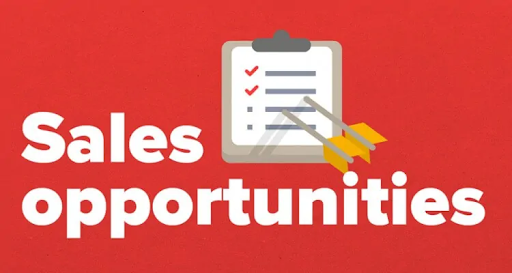
You’ve talked to all the people involved in the story, you’ve done a stakeout to catch the culprits in the act, and you’ve even filled up one of those little memo pads with all the notes for your story. Now what?
It’s time to put it all on the line and pitch your story.
Sure, you’ve done your best to determine the fit and have extracted all the juicy details to make things as interesting and beneficial as they can be. But it all comes down to whether the decision-maker thinks it’s worthy of a spot on the page (purchase).
That’s what an opportunity is for reps. It’s the point at which a prospect agrees to consider your solution.
Important: If a prospect is not willing to seriously talk about and consider either changing from their current solution or just using you for the first time — they are not a prospect. Regardless, you should re-engage with them later to see if the lead is ready to consider a new solution.
You can’t sell to someone who’s not interested. You can explain the benefits and pour them a glass, but it takes self willingness to consider them to be potential customers.
You obviously desire to sell your products to those who need them. Therefore, the opportunity hinges on the potential customer.
Once your prospect decides they need to consider your solution, it genuinely is a sales opportunity.
Differentiating Between Leads & Prospects & Opportunity
You hear from sales teams all the time, and they often interchange the terms:
- Prospect vs lead
- Lead vs opportunity
- Prospect vs opportunity.
They’ll even use them interchangeably in the same sentence!
Are they all the same?
Terminology in sales isn’t just jargon, and it can be confusing.
So many ways to slap a label on someone.
Sadly, there are so few sales-facing teams who have a solid grasp of the terms.
In a nutshell, this is how to look at it via this quick image we put together:
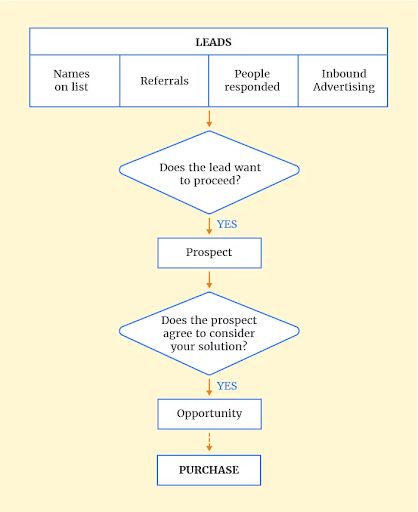
To tackle the overall confusion, we’ve laid out three of the most commonly used terms:
- Sales prospects
- Sales leads
- Sales opportunities
We’ll examine and cross-examine each one until you have a firm understanding of each.
Lead Vs Prospect
Sometimes there’s confusion between lead vs prospect.
A lead is someone who has shown interest in your products/services but yet is unqualified to take the next step towards conversion, for example by filling out a form on their website or downloading an e-book.
While a prospect just needs more information before they are ready for sales conversations, so we nurture them by sending nurturing emails. That’s why we call them qualified leads ready to enter the sales process.
That’s the difference between lead and prospect.
Lead Vs Opportunity
The moment a prospect starts considering changing the product or service and starts thinking about opting for your solution is the moment where he becomes an opportunity.
Unlike leads, who are a vague and blurry number of people that need to be processed and typically identified in order to highlight potential prospects that could fit and qualify to become an opportunity.
5 Ways on How to Turn a lead Into Prospect
In order to turn a lead into a prospect, you need to qualify them.
A lead is an unqualified contact who needs additional information in order to make a decision and identify if they are qualified or not to become a prospect or a potential prospect.
Leads are considered like fish in the market of products and services but haven’t made up their mind yet about using your solution.
It’s like you’re fishing for leads.
1. Qualify your leads
In order to qualify your leads, you need to ask the right questions in order to get them talking.
This is a tactic called “qualifying your leads” and it can be done by asking relevant, open-ended questions that will lead them into revealing their pain points and what they’re looking for from a solution like yours.
Once you qualify your leads, it will be easier to know which ones are worth pursuing and how much time and energy is needed on each lead in order to convert them into customers.
2. Nurture your leads
Through applying lead generation strategies and efforts, you will end up catching the interest of leads who are considered to qualify for being either potential customers or customers.
At this point, you need to provide them with more information about your business.
We recommend a consistent and well-planned communication strategy, sending out a newsletter or an article you think they would be interested in reading to get the conversation started.
You can also share with them blog posts that are related to their interests and use social media like Facebook, LinkedIn, Twitter, Instagram, Direct Telephone… All offered through our solution.
Always keep in mind that cross-selling and up-selling opportunities are not to be missed when it comes to nurturing leads.
3. Collect information about your leads
Collecting the right information about your leads is a crucial step in order to identify and turn them into prospective customers.
LeadFuze is a tool to collect information about leads. It automatically gathers all the necessary data, including:
- Email addresses
- Social media profiles
- Phone numbers
- Position
- Location
- Salary
- Company information
- Account information
- Etc.
As this example will show you.
You can choose either a Market Based or Account-Based Search, set your search criteria, and insert your desired filters and launch your search.
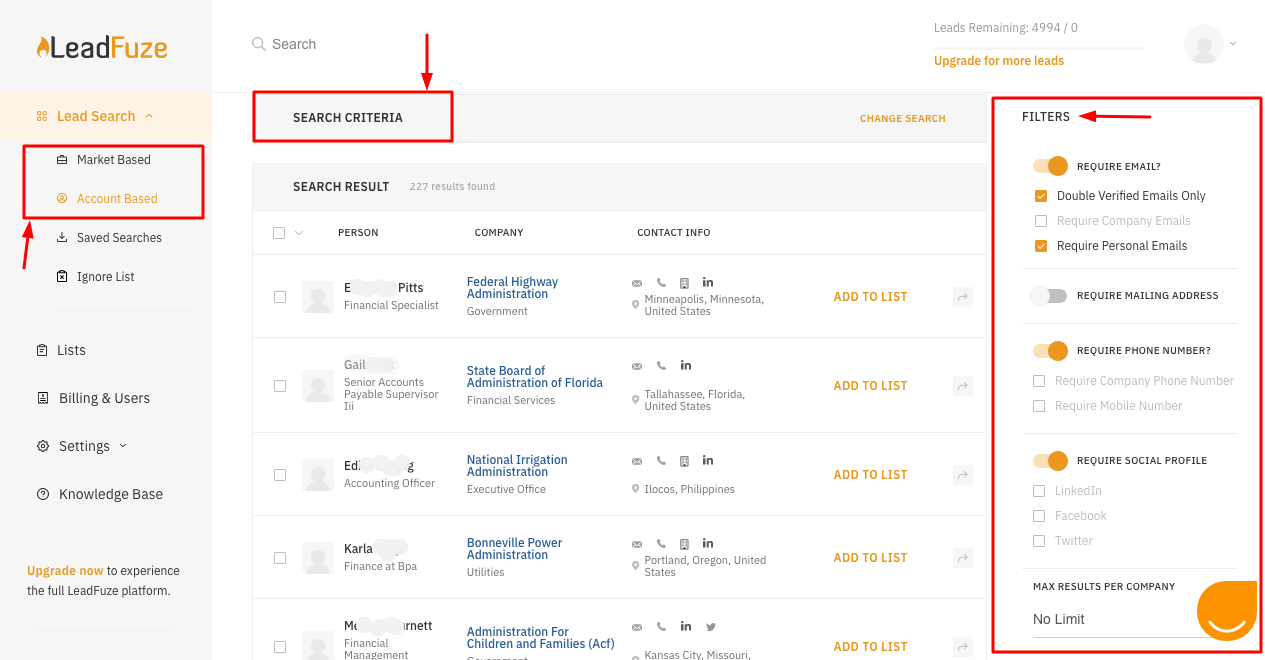
Based on your input criteria, if you open up a profile this is what it will look like.
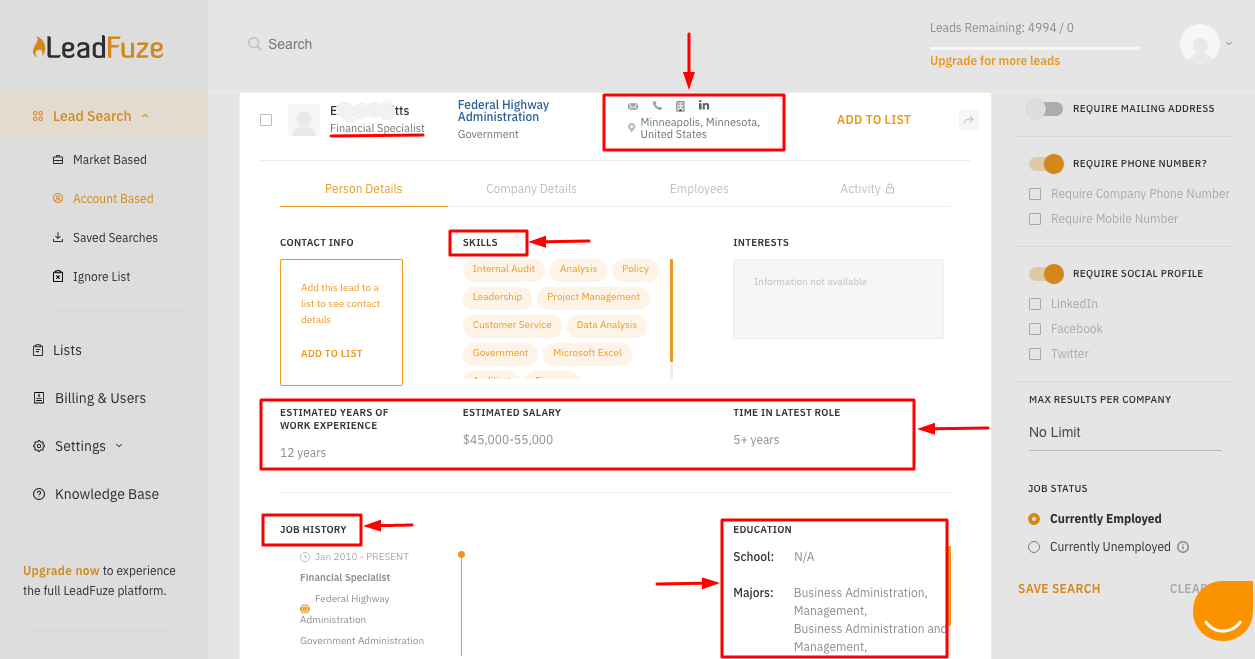
For you to have an idea on the components that are included in the search criteria, here’s what it looks like:
- Company Criteria
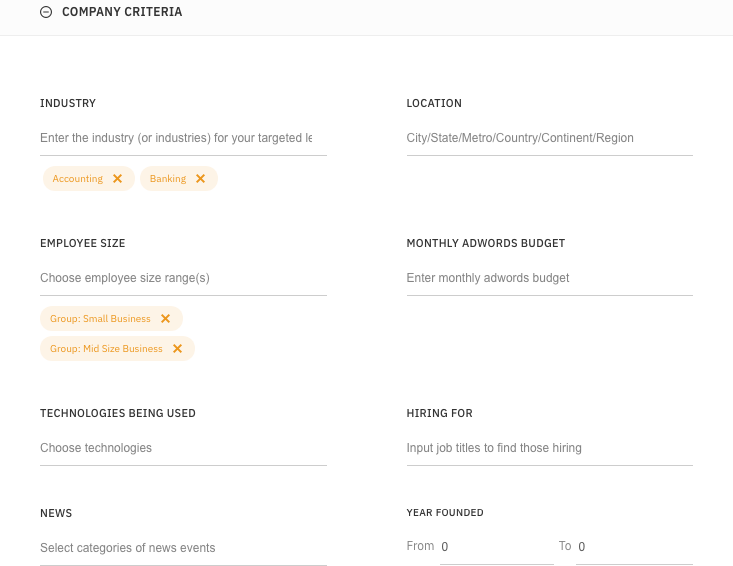
- People Criteria
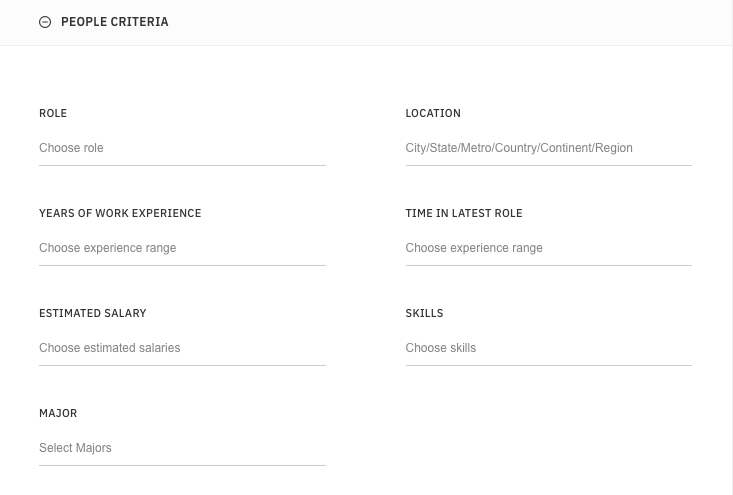
The software matches and verifies lead information in real-time, making prospecting easier and faster.
You can put your list building on autopilot, then sit back as Fuzebot, our A.I. assistant, will automatically add new leads he finds in the future that match your criteria.
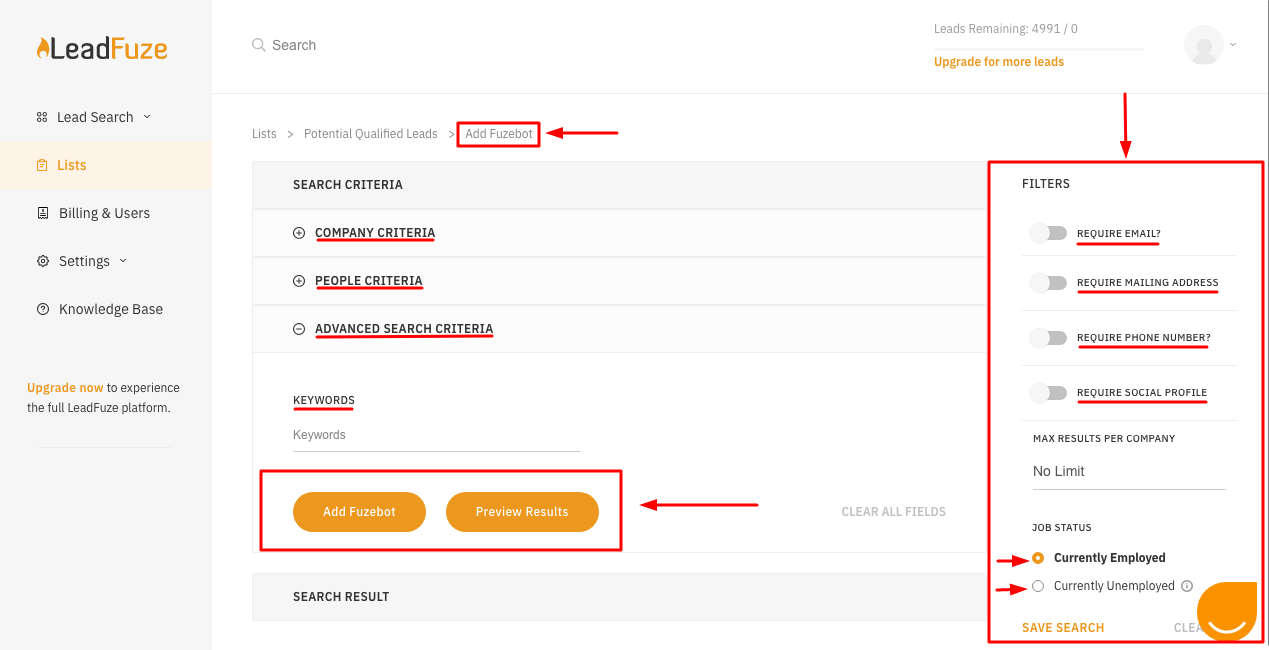
You can manage your Fuzebot functions whether to pause or run it, edit the name, export list data, or delete it.
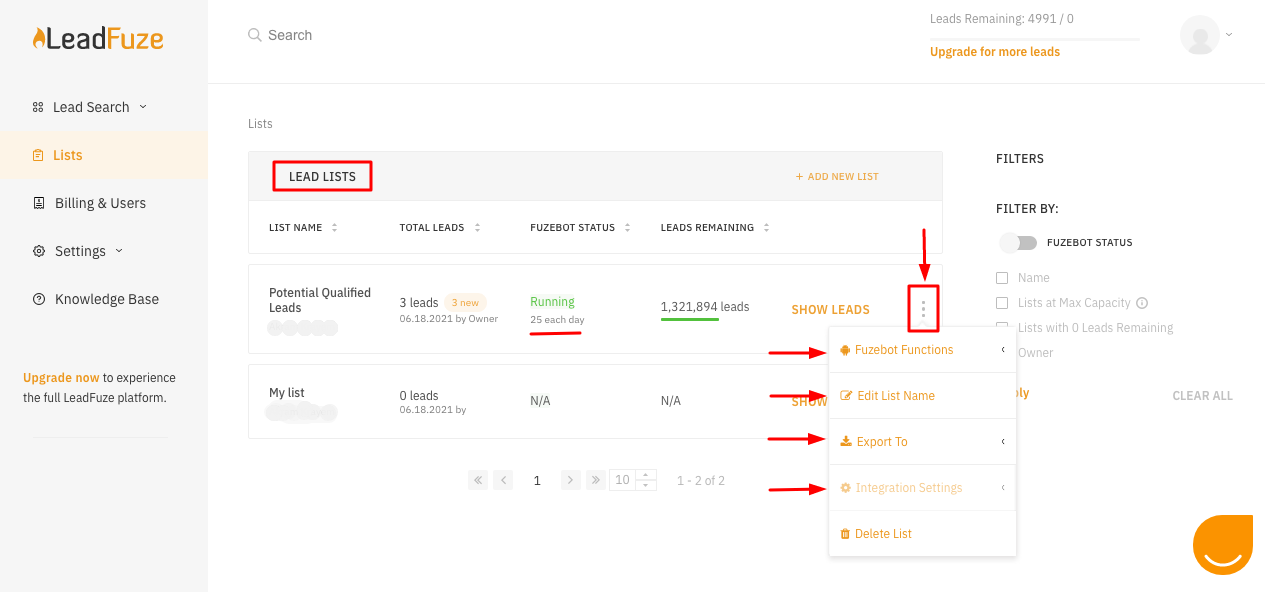
Fuzebot can also drip them into your CRM or workflow tools to automatically trigger outreach campaigns.
4. Offer helpful solutions
Another approach to the way you can turn a lead into a prospect is by offering helpful solutions.
You can offer to help them right away with any problems they are having, and remind them of the benefits that your product or service has to offer in order to make them consider using your solution.
For example, if some lead asks about how to handle an issue, provide help and emphasize on how your software handles that specific issue, the advantages it offers, and how it could enrich their sales funnel.
5. Be social
Leads in marketing are more likely to engage with brands that they feel like know them, relatable, and understand their needs
Being constantly active on social media platforms and on your website, through email marketing campaigns, responding to comments and frequently asked questions, or even at in-person events.
These are all easy ways to keep leads engaged on the topics of interest and establish two-way conversations, which may result in leads turning into prospects or remaining potential prospects.
LeadFuze search includes showing you social accounts of profiles such as Linkedin… Making it as it gets for you to establish a social connection with your leads.
Through the social activity, leads or potential leads will subconsciously have your company on their minds thanks to your marketing, engagement campaigns, and lead generation efforts.
Conclusion
After you have learned the difference between lead and prospect through our comparison of prospect vs lead.
To conclude, all efforts reside in a Funnel.
Generating leads, identifying their type, qualifying them, and turning them from a simple lead into sales opportunities and regular customers in the long run.


